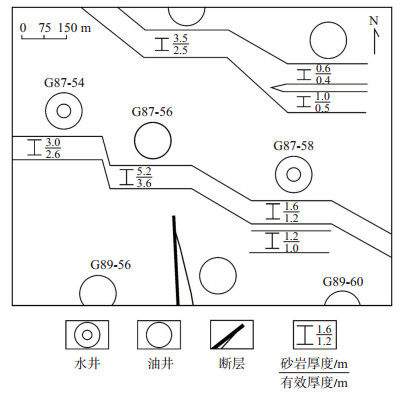2. 中国石油大庆油田有限责任公司 勘探开发研究院, 黑龙江 大庆 163712
2. Research Institute of Exploration and Development, PetroChina Daqing Oilfield Company Ltd., Daqing 163712, Heilongjiang, China
葡西油田G137区块水驱控制程度达79%,而油田却有50%以上油井因注水不受效关井或转为捞油。此种情况存在2种解释:一是储层非均质影响,井间储层物性变差[1-3];二是按照非达西渗流理论,当井距偏大,低渗透储层无法实现有效驱动[4-6]。无论哪种原因均说明仅用水驱控制程度评价注采系统的适应性已经不能满足油田开发的需求。
随着勘探开发工作的深入,每年新投入开发的石油地质储量中80%以上为低渗透储层[7-9]。因此,合理评价这部分储层注采系统的适应性显得尤为重要。笔者利用产液剖面和吸水剖面资料,统计分析静态连通厚度与实际水驱波及厚度的关系,根据有效连通系数计算结果评价低渗透油田注采系统的适应性,以期为客观评价油田注采系统适应性提供一个新的评价参数[10-12]。
1 有效连通系数计算有效连通系数(η)是注水受效厚度(h0)与砂体静态连通厚度(h)的比值。具体计算流程:①根据每个井组的射孔层位及砂体连通图,确定砂体静态连通厚度;②对于静态连通的井组,利用产液剖面、吸水剖面及开发动态数据确定注水受效厚度;③计算注水受效厚度与砂体静态连通厚度的比值。应用小层平面图确定砂体静态连通厚度后,计算的水驱控制程度称为视水驱控制程度。有效连通系数与视水驱控制程度乘积称真水驱控制程度。
1.1 静态连通厚度根据小层平面图判断注采井间储层是否连通,称为静态连通。由图 1可以看出,葡西油田G137区块G87-56井与G87-54,G87-58井砂体均连通,判定为双向静态连通,静态连通厚度为3.6 m。逐层判定后,全井静态连通厚度为各层之和。该井静态连通厚度为6.9 m。

|
下载eps/tif图 图 1 PI4层小层平面图 Fig. 1 Sand body distribution of PI4 sublayer |
根据生产动态及注入剖面和产液剖面的关系综合判定注水受效厚度,判定注水受效层原则:一是注、采井间为静态连通;二是注水井按配水量正常注水,且注入层注入百分比大于等于10%;三是采油井受效特征明显,且产液剖面判断受效层含水有上升趋势。
以G87-56井组为例,G87-56井为采油井,周围2口注水井分别为G87-54井和G87-58井。G87-56井2004年12月正式投产,射开PI2,PI4,PI6层,砂岩厚度分别为5.7 m,5.2 m和1.6 m,有效厚度分别为3.3 m,3.6 m和0 m;初期平均日产液1.13 t,平均日产油1.07 t,综合含水率4.5%,液面深度1 300 m左右,流压6.2 MPa。2006年12月压裂,压裂后前3个月平均日产液1.9 t,日产油1.8 t,综合含水率4.5%,后期以稳定日产油1.0 t进行生产,液面深度1 600 m左右,井底流压在3.5 MPa,至2008年4月含水率上升,液量下降,2009年5月综合含水率上升到66.7%,油井受效特征明显。该井自2006年共测产液剖面4次,从4次测试结果可以看出,PI2,PI4层均为该井的主产层,注水且受效特征明显,PI6层不产液(表 1)。
|
|
下载CSV 表 1 G87-56井产液剖面测试结果 Table 1 Fluid production profile testing results of well Gu87-56 |
G87-58井射开PI2,PI4,PI6-9层等6个小层,2004年10月投注,至2005年6月日注入量25 m3,注入压力18.0 MPa,2005年7月调试方案,日注入量为14 m3,注入压力为18.8 MPa,2006年4月提高日注入量平均为30 m3,注入压力稳定在18.7 MPa,2007年8月实施周期注水,日注入量逐步下降,由日注入量16 m3降到2010年3月的12 m3,而注入压力一直稳定在18.0 MPa以上(表 2)。该井进行过5次注入剖面测试,从注入剖面分析,PI2,PI4,PI9层均为主力吸水层。
|
|
下载CSV 表 2 G87-58井注入剖面测试结果 Table 2 Fluid injection profile testing results of well Gu87-58 |
葡西油田G137区块G87-54井射开PI2,PI4,PI6,PI7层等4个小层。2004年11月投注时全井不吸水,关井至2005年11月重新投注,日注入量22 m3,注入压力18.3 MPa,4个月后因井口问题关井,2007年4月作业后开井注入,采用间注方式注水,日注入量为20 m3,注入压力为18.8 MPa,2008年1-4月挤火油关井,2008年11月到2009年4月挤火油关井,注入期间日注入量逐渐下降,注入压力保持在19.0 MPa,全井未按配注方案注入,注水不正常。由该井2次注入剖面测试结果看出,尽管PI2,PI4,PI6,PI7层等4个小层有不同程度的吸水量(表 3),但整体吸水量差,在实施作业、采用间注的注水方式、降低日注入量的情况下,这口井仍然不能完成配注量。
|
|
下载CSV 表 3 G87-54井注入剖面测试结果 Table 3 Fluid injection profile testing results of well Gu87-54 |
综上所述,根据受效厚度判定原则,判定G87-56井与G87-58井间的PI2,PI4层连通,而与G87-54井的PI2,PI4层不连通,G87-56井组为单向注水受效,受效厚度为6.9 m。
1.3 有效连通系数计算结果G87-56井组静态连通厚度为6.9 m,注水受效厚度为6.9 m,计算有效连通系数为1.0。同理,在葡西油田开发试验区和G137区块选择21个井组,计算其有效连通系数分别为0.62和0.87(表 4,5)。
|
|
下载CSV 表 4 葡西油田开发试验区有效连通系数计算数据 Table 4 Effective connectivity coefficien of the test area in Puxi Oilfield |
|
|
下载CSV 表 5 葡西油田G137区块有效连通系数计算数据 Table 5 Effective connectivity coefficien of G137 block in Puxi Oilfield |
有效连通系数概念的提出,将注采系统研究中常用的真水驱控制程度描述为视水驱控制程度和有效连通系数,实现了静态连通和动态连通的分阶段评价,对分析现有井网不能建立有效驱动体系的原因具有重要意义。如葡西油田试验区和G137区块同样是注水受效差,但其受效差的原因却有本质的不同,由表 6可以看出,试验区视水驱控制程度为55.9%,有效连通系数为0.87,说明该区块注水受效差的主要原因是砂体规模小所致,砂体静态不连通,而G137区块视水驱控制程度为79.0%,有效连通系数为0.62,说明该区块注水受效差的主要原因是储层物性差所致,砂体静态连通但动态反应不连通。值得指出的是,2区块真水驱控制程度仅为48.6%和48.9%,而应用小层平面图计算的视水驱控制程度掩盖了这一事实。因此,对于低渗透油田,将油田开发的水驱控制程度考核指标分解为视水驱控制程度和有效连通系数更为合理。
|
|
下载CSV 表 6 葡西油田不同渗透率储层有效连通系数对比 Table 6 Effective connectivity coefficien of reservoirs with different permeability in Puxi Oilfield |
(1)对于低渗透油藏,根据砂体静态连通关系计算的水驱控制程度不能真实地反映油田的水驱控制程度,有效连通系数与视水驱控制程度的乘积才是低渗透油田水驱控制程度的真实值,即真水驱控制程度。
(2)将真水驱控制程度分解为视水驱控制程度和有效连通系数,用其评价低渗透油藏更为合理。
| [1] |
王焕, 黄伟明, 贺梦琦, 等. 考虑有效驱动体系的合理井网密度计算方法. 合肥工业大学学报(自然科学版), 2018, 41(8): 1108-1111. WANG H, HUANG W M, HE M Q, et al. Calculation method of reasonable well pattern density considering effective driving system. Journal of Hefei University of Technology(Natural Science), 2018, 41(8): 1108-1111. DOI:10.3969/j.issn.1003-5060.2018.08.018 |
| [2] |
赵习森, 党海龙, 庞振宇, 等. 特低渗储层不同孔隙组合类型的微观孔隙结构及渗流特征:以甘谷驿油田唐157井区长6储层为例. 岩性油气藏, 2017, 29(6): 8-14. ZHAO X S, DANG H L, PANG Z Y, et al. Microscopic pore structure and seepage characteristics of different pore assemblage types in ultra low permeability reservoir:a case of Chang 6 reservoir in Tang 157 well area, Ganguyi Oilfield. Lithologic Reservoirs, 2017, 29(6): 8-14. DOI:10.3969/j.issn.1673-8926.2017.06.002 |
| [3] |
徐波, 王建, 于乐丹, 等. 致密油储层成岩相类型及其对产能的影响:以鄂尔多斯盆地姜家川地区长8储层为例. 岩性油气藏, 2018, 30(6): 109-116. XU B, WANG J, YU L D, et al. Diagenetic facies types of tight reservoir and its effects on productivity:a case of Chang 8 reservoir in Jiangjiachuan area, Ordos Basin. Lithologic Reservoirs, 2018, 30(6): 109-116. |
| [4] |
苗志国. 有效驱动系数对低和特低渗透储层开发效果的影响. 大庆石油地质与开发, 2016, 35(2): 43-47. MIAO Z G. Influence of effective driving coefficient on the development effects of low and extra-low-permeability reservoirs. Petroleum Geology and Oilfield Development in Daqing, 2016, 35(2): 43-47. DOI:10.3969/J.ISSN.1000-3754.2016.02.007 |
| [5] |
朱圣举, 张皎生, 安小平, 等. 低渗透油藏菱形反九点井网产量计算研究. 岩性油气藏, 2012, 24(6): 115-120. ZHU S J, ZHANG J S, AN X P, et al. Oil production calculation for rhombic inverted nine-spot areal well pattern of low permeability reservoirs. Lithologic Reservoirs, 2012, 24(6): 115-120. DOI:10.3969/j.issn.1673-8926.2012.06.023 |
| [6] |
罗健辉, 王平美, 彭宝亮, 等. 低渗透油田水驱扩大波及体积技术探讨. 油田化学, 2017, 34(4): 756-760. LUO J H, WANG P M, PENG B L, et al. Discussion on expanding swept volume technique of water flooding in low permeability oilfield. Oilfield Chemistry, 2017, 34(4): 756-760. |
| [7] |
石成方. 油田注水开发效果评价方法研究. 北京: 中国地质大学(北京), 2009. SHI C F. Research on evaluation method of oilfield water injection development effect. Beijing: China University of Geosciences(Beijing), 2009. |
| [8] |
张俊法. 高含水油田开发效果评价与挖潜研究:以卡多夫油田为例. 北京: 中国地质大学(北京), 2010. ZHANG J F. Research on development effect evaluation and potential tapping of high water cut oil field:Take Cardorf Oilfield as an Example. Beijing: China University of Geosciences(Beijing), 2010. |
| [9] |
刘芬, 朱筱敏, 潘荣, 等. 低渗透储层形成及库车坳陷实例分析. 岩性油气藏, 2014, 26(3): 28-37. LIU F, ZHU X M, PAN R, et al. Formation of low permeability reservoir and typical case analysis in Kuqa Depression. Lithologic Reservoirs, 2014, 26(3): 28-37. DOI:10.3969/j.issn.1673-8926.2014.03.006 |
| [10] |
陶帅, 郝永卯, 周杰, 等. 透镜体低渗透岩性油藏合理井网井距研究. 岩性油气藏, 2018, 30(5): 116-123. TAO S, HAO Y M, ZHOU J, et al. Reasonable pattern well spacing deployment of lens lithologic reservoirs with low permeability. Lithologic Reservoirs, 2018, 30(5): 116-123. |
| [11] |
毛文静. 低渗透油藏井网优化及开发技术政策研究. 四川地质学报, 2013, 33(4): 399-403. MAO W J. A study of Well pattern optimization and developmental tech niquein the low permeable oil reservoir. Journal of Sichuan Geology, 2013, 33(4): 399-403. |
| [12] |
王柏程.特低渗透储层动用界限及建立驱动体系研究.大庆: 东北石油大学, 2017. WANG B C. Research on the utilisation limit and establishment of driving system for ultra-low permeability reservoirs. Daqing: Northeast Petroleum University, 2017. |
 2019, Vol. 31
2019, Vol. 31



